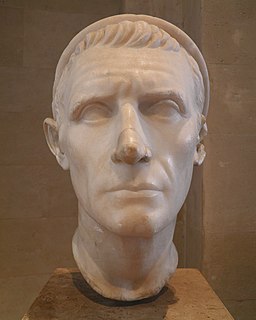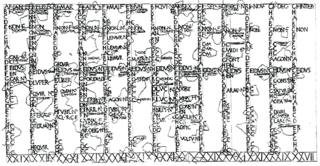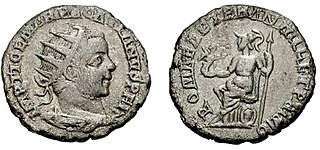
The 2nd century BC started the first day of 200 BC and ended the last day of 101 BC. It is considered part of the Classical era, although depending on the region being studied, other terms may be more suitable. It also considered to be the end of the Axial Age. In the context of the Eastern Mediterranean, it is referred to as the Hellenistic period.
This article concerns the period 209 BC – 200 BC.
This article concerns the period 129 BC – 120 BC.
This article concerns the period 239 BC – 230 BC.
This article concerns the period 199 BC – 190 BC.
Year 67 BC was a year of the pre-Julian Roman calendar. At the time it was known as the Year of the Consulship of Piso and Glabrio. The denomination 67 BC for this year has been used since the early medieval period, when the Anno Domini calendar era became the prevalent method in Europe for naming years.
Year 209 BC was a year of the pre-Julian Roman calendar. At the time it was known as the Year of the Consulship of Verrucosus and Flaccus. The denomination 209 BC for this year has been used since the early medieval period, when the Anno Domini calendar era became the prevalent method in Europe for naming years.
Year 190 BC was a year of the pre-Julian Roman calendar. At the time it was known as the Year of the Consulship of Asiaticus and Laelius. The denomination 190 BC for this year has been used since the early medieval period, when the Anno Domini calendar era became the prevalent method in Europe for naming years.

Antiochus III the Great was a Hellenistic Greek king and the 6th ruler of the Seleucid Empire. He ruled over the region of Syria and large parts of the rest of western Asia towards the end of the 3rd century BC. Rising to the throne at the age of eighteen in 222 BC, his early campaigns against the Ptolemaic Kingdom were unsuccessful, but in the following years Antiochus gained several military victories and substantially expanded the empire's territory. His traditional designation, the Great, reflects an epithet he assumed. He also assumed the title Basileus Megas, the traditional title of the Persian kings. A militarily active ruler, Antiochus restored much of the territory of the Seleucid Empire, before suffering a serious setback, towards the end of his reign, in his war against Rome.
The gens Acilia was a plebeian family at Ancient Rome, that flourished from the middle of the third century BC until at least the fifth century AD, a period of seven hundred years. The first of the gens to achieve prominence was Gaius Acilius Glabrio, who was quaestor in 203 and tribune of the plebs in 197 BC.

Arsaces II, was the Arsacid king of Parthia from 217 BC to 191 BC.

The Battle of Thermopylae was fought in 191 BC between a Roman army led by consul Manius Acilius Glabrio and a Seleucid force led by King Antiochus III the Great. It was the first major battle of the Roman–Seleucid War. The Romans were victorious, and as a result, Antiochus was forced to flee from Greece.
Manius Acilius Glabrio was a Roman Senator who served as consul ordinarius in AD 91 as the colleague of Trajan, afterwards emperor. Although one of many senators executed during the reign of Domitian on the alleged grounds of plotting against the emperor, he was remembered by his contemporaries best for his strength. Domitian summoned Glabrio during the latter's consulate to his Alban estate during the festival of the Juvenalia to kill a large lion; not only did Glabrio despatch the beast, but he escaped all injury. Following his defeat of the lion, Glabrio was banished by Domitian, then executed while in exile.

The Aetolian War was fought between the Romans and their Achaean and Macedonian allies and the Aetolian League and their allies, the kingdom of Athamania. The Aetolians had invited Antiochus III the Great to Greece, who after his defeat by the Romans had returned to Asia. This left the Aetolians and the Athamanians without any allies. With Antiochus out of Europe the Romans and their allies attacked the Aetolians. After a year of fighting the Aetolians were defeated and forced to pay 1,000 talents of silver to the Romans.
Quintus Minucius Thermus was a consul of the Roman Republic in 193 BC.
Spurius Ligustinus was a Roman of Sabine origin soldier and centurion in the Roman army during the 2nd century BC.













